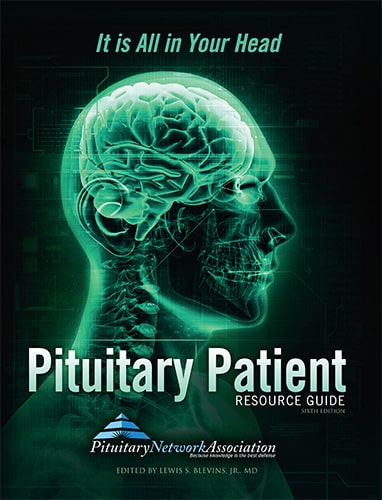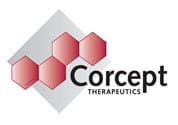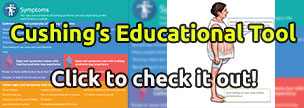Pituitary Glossary starting with C
Calcification
The strengthening and hardening of a bone in areas where calcium has been deposited.
Nearly all calcium entering the body is deposited in bones and teeth. The remaining calcium is dissolved in the blood. When a disorder affects the balance between calcium and other minerals or chemicals in the body, calcium can be deposited in other parts of the body, such as arteries, kidneys, lungs, and brain, and can cause problems in their normal function. Calcifications can usually be diagnosed using x-rays.
CAMP
Cyclic adenosine monophosphate.
The adrenal gland produces a hormone called epinephrine, which travels to the body’s cells and causes an increase in blood sugar. The sugar gives the body energy to react to stressful situations. Cyclic adenosine monophosphate (cAMP), stimulates the breakdown of stored carbohydrate into sugar.
Cancer
General term frequently used to indicate any of various types of malignant neoplasms.
Most cancers invade surrounding tissues, may metastasize to several sites, and are likely to recur after attempted removal and to cause death of the patient unless adequately treated.
Carcinoma
A malignant tumor that arises from epithelium found in skin or, more commonly, the lining of body organs
Carcinomas can be found in the breast, prostate, lung, stomach or bowel. Carcinomas tend to infiltrate into adjacent tissue and spread (metastasize) to distant organs, for example, to bone, liver, lung or the brain.
Carotid Artery
The artieries which carry blood up through the neck, eventually supplying the brain with its major blood supply.
Carotid artery: Either of the two key arteries located in the front of the neck, through which blood from the heart goes to the brain. The right and left common carotid arteries are located on each side of the neck. Together, these arteries provide the principal blood supply to the head and neck. The left common carotid artery arises directly from the aorta. The right common carotid artery arises from the brachiocephalic artery, which, in turn, comes off the aorta. Each of the two divides to form external and internal carotid arteries. Cholesterol plaque on the inner wall of the carotid artery can lead to a stroke. These vessels are also found within the cavernous sinus.
Catheter
A tubular instrument to allow passage of fluid from or into a body cavity.
Tubular device inserted into a duct, blood vessel, hollow organ, or body cavity for injecting or withdrawing fluids. Examples of use; heart or urinary catheterization. Catheterization is also used for diagnostic purposes.
Cavernous Sinus
Area adjacent to the sphenoid sinus containing several vital nerves and blood vessels.
A large channel of venous blood creating a “sinus” cavity bordered by the sphenoid bone and the temporal bone of the skull. The cavernous sinus is an important structure because of its location and its contents which include the third cranial (oculomotor) nerve, the fourth cranial (trochlear) nerve, parts 1 (the ophthalmic nerve) and 2 (the maxillary nerve) of the fifth cranial (trigeminal) nerve, and the sixth cranial (abducens) nerve.
A cavernous sinus thrombosis is a blood clot within the cavernous sinus. This clot causes the cavernous sinus syndrome.
Cell
The basic living unit of body tissue. It contains a nucleus surrounded by cytoplasm and is enclosed by a membrane.
Minute protoplasmic masses that make up organized tissue, consisting of a nucleus which is surrounded by protoplasm which contains the various organelles and is enclosed in the cell or plasma membrane; cells are the fundamental, structural, and functional units of living organisms.
Central Nervous System (CNS)
Pertaining to the brain, cranial nerves and spinal cord. It does not include muscles or peripheral nerves.
The central nervous system (CNS) is made up of the spinal cord and brain. The brain receives nerve impulses from the spinal cord and cranial nerves. The spinal cord contains the nerves that carry messages between the body and the brain. Spinal cord injury occurs when there is damage to the cells within the spinal cord or the nerves of the spinal cord are severed.
Cerebral
Referring to the cerebrum.
Of or relating to the brain or the intellect.
Cerebrospinal Fluid (CSF)
The clear fluid made in the ventricular cavities of the brain that bathes the brain and spinal cord. It circulates through the ventricles and the subarachnoid space.
The fluid that flows in and around the hollow spaces of the brain and spinal cord, and between two of the meninges (the thin layers of tissue that cover and protect the brain and spinal cord). Cerebrospinal fluid is made by tissue called the choroid plexus in the ventricles (hollow spaces) in the brain. Also called CSF. Cerebrospinal fluid analysis involves the removal of a small amount of the fluid that protects the brain and spinal cord. The fluid is tested to detect any bleeding or brain hemorrhage, diagnose infection to the brain and/or spinal cord, identify some cases of multiple sclerosis and other neurological conditions, and measure intracranial pressure.
Cerebrum
The largest area of the brain, the cerebrum occupies the uppermost part of the skull. It consists of two halves called hemispheres. Each half of the cerebrum is further divided into four lobes: frontal, temporal, parietal and occipital.
The forebrain is the largest and most highly developed part of the human brain; it consists primarily of the cerebrum and the structures hidden beneath it. The cerebrum sits at the outermost part of the brain and is the source of intellectual activities. It holds memories, allows you to plan, enables you to imagine and think, to recognize friends, read books, and play games. The cerebrum is split into two halves (hemispheres) by a deep fissure. Despite the split, the two cerebral hemispheres communicate with each other through a thick tract of nerve fibers that lies at the base of this fissure. Although the two hemispheres seem to be mirror images of each other, they are different. For instance, the ability to form words seems to lie primarily in the left hemisphere, while the right hemisphere seems to control many abstract reasoning skills.
Chemotherapy
Treatment of disease by means of chemical substances or drugs; usually used in reference to neoplastic (cancer) disease.
Chemotherapy is a body-wide (systemic) treatment the use of drugs to kill bacteria, viruses, fungi, and cancer cells; administered by mouth or injection. Most commonly, the term is used to refer to cancer-killing drugs.
Circumscribed
Having a border, localized.
Often associated with a capsule and benign tumors of the brain. For example, meningiomas, pituitary adenomas and acoustic neuromas. See diffuse.
Claustrophobic
A morbid fear of being in a confined place.
Claustrophobia; suffering from an abnormal dread of being in closed or narrow spaces.









